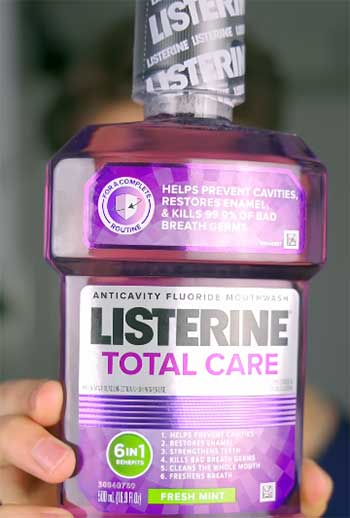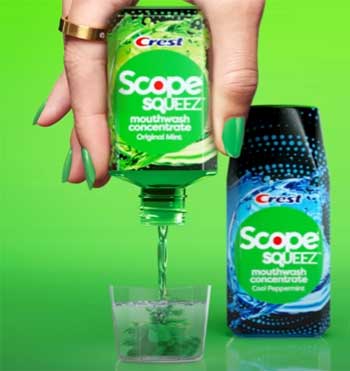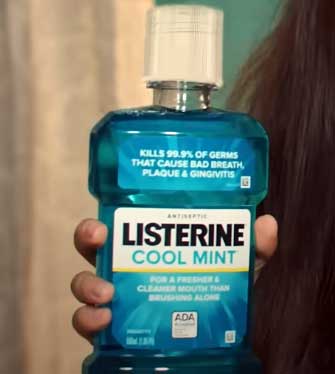I’ve always been a bit obsessed with keeping my breath fresh and my oral health on point. So, when it came to choosing between Listerine and Scope, two heavyweights in the mouthwash world, I wanted to understand what each brings to the table.
This article is my journey to compare Listerine and Scope, breaking down their pros, cons, and key features from a real user’s perspective.
I’ll share insights to help you decide which mouthwash suits your needs, whether you’re fighting bad breath, aiming for healthier gums, or just want a cleaner mouth.
A Brief Comparison Table
| Feature | Listerine | Scope |
| Primary Focus | Plaque, gingivitis, bad breath | Bad breath, plaque |
| Key Ingredients | Essential oils (eucalyptol, menthol, thymol, methyl salicylate), alcohol | Cetylpyridinium chloride (CPC), alcohol |
| Alcohol Content | Yes (up to 26.9%) | Yes (up to 15%) |
| ADA Seal | Yes (select formulas) | No |
| Flavors | Cool Mint, Freshburst, Zero Alcohol variants | Classic Mint, Outlast, Fresh Mint |
| Price (per ounce) | ~$0.20–$0.30 | ~$0.15–$0.25 |
| Burn Sensation | Strong (alcohol-based) | Moderate (lower alcohol content) |
| Best For | Gum health, plaque reduction | Bad breath, affordability |
Why Mouthwash Matters To Me?

I’ll admit it—I’m a bit of a dental hygiene nerd.
Brushing and flossing are non-negotiable, but mouthwash?
That’s the cherry on top of my oral care routine. It’s not just about fresh breath (though that’s a big perk).
Mouthwash can tackle bacteria, reduce plaque, and even help prevent gum disease.
But with so many options, I wanted to zoom in on Listerine and Scope, two brands I’ve seen on shelves forever.
They’re both trusted, but they’re not identical.
Let’s explore what makes each one tick and how they stack up.
Listerine: The Bold, Intense Choice
Listerine has been around since the 1800s, and it’s got a reputation for being the tough guy of mouthwashes.
When I first tried Listerine Cool Mint, I was hit with that signature burn—yep, it’s intense! That’s thanks to its high alcohol content, which can go up to 26.9% in some formulas.
The burn isn’t just for show; it’s part of what makes Listerine feel like it’s working hard to blast away bacteria.
Key Features of Listerine
Listerine’s formula is built around a blend of four essential oils: eucalyptol, menthol, thymol, and methyl salicylate.
These give it antimicrobial properties that target plaque and gingivitis-causing bacteria.

I love that many Listerine products, like Listerine Total Care and Freshburst, carry the American Dental Association (ADA) Seal of Acceptance, which means they’ve been rigorously tested for safety and effectiveness.
The brand also offers alcohol-free options, like Listerine Zero, for those who want a gentler rinse.
Listerine’s range is impressive.
Whether you’re after cavity protection, enamel strengthening, or just a minty-fresh kick, there’s a variant for you.
I’ve tried the Total Care, which claims to do it all—fight cavities, strengthen teeth, and freshen breath.
It’s a multitasker, and I appreciate that. But the alcohol-based versions can be a bit much if you’re sensitive or have dry mouth.
Pros of Listerine
- Proven Effectiveness: The ADA Seal on select formulas backs its ability to reduce plaque and gingivitis. Studies show Listerine can cut plaque by up to 52% more than brushing and flossing alone.
- Versatile Range: From alcohol-free to whitening formulas, there’s something for everyone.
- Long-Lasting Freshness: That minty zing sticks around, keeping my breath fresh for hours.
- Gum Health Focus: Its essential oils are clinically proven to tackle gingivitis-causing bacteria, which is great if you’re prone to gum issues.
Cons of Listerine
- Intense Burn: The high alcohol content can feel like a fire in your mouth, which isn’t everyone’s cup of tea.
- Dry Mouth Risk: Alcohol can dry out your mouth, potentially worsening bad breath or cavity risk over time.
- Strong Flavor: The minty taste can be overpowering, sometimes lingering longer than I’d like.
- Not Ideal for Kids: Most formulas are for ages 12 and up due to the alcohol content.
Scope: The Fresh Breath Champion
Scope, a Procter & Gamble brand, feels like the friendlier, less aggressive cousin of Listerine. When I swished with Scope Classic Mint, I noticed it’s less harsh, with a smoother, less fiery feel.
That’s likely because Scope uses less alcohol—around 15% in most formulas. It’s designed to focus on fresh breath and plaque control, and it’s been a go-to for many since its debut in the 1960s.
Key Features of Scope

Scope’s star ingredient is cetylpyridinium chloride (CPC), an antiseptic that targets bad breath and plaque-causing bacteria.
Unlike Listerine, Scope doesn’t have the ADA Seal, which might give some folks pause.
However, it’s widely available and often cheaper than Listerine, making it a budget-friendly pick.
I found Scope Outlast particularly impressive for its claim of up to five times longer-lasting freshness compared to brushing alone.
Scope’s flavors, like Classic Mint and Outlast, are crisp and refreshing without being overwhelming. It’s a solid choice if you want a quick rinse that doesn’t feel like a workout for your taste buds.
But it’s not as focused on gum health as Listerine, which might matter if you’re dealing with gingivitis.
Pros of Scope
- Gentler Experience: Lower alcohol content means less burn, making it more comfortable for sensitive mouths.
- Affordable: Often cheaper per ounce than Listerine, it’s a great value pick.
- Bad Breath Fighter: CPC is effective at killing odor-causing bacteria, leaving my breath fresh for hours.
- Widely Available: You can find Scope in almost any drugstore or supermarket.
Cons of Scope
- No ADA Seal: Unlike Listerine, Scope lacks that official stamp of approval, which might make you question its efficacy.
- Limited Scope (Pun Intended): It’s primarily focused on bad breath, not as robust for gum health or cavity prevention.
- Alcohol Presence: While less than Listerine, it still contains alcohol, which can dry out your mouth.
- Fewer Variants: Scope’s range isn’t as diverse as Listerine’s, so you might not find a formula tailored to your specific needs.
How Listerine And Scope Mouthwash Compare?
Let’s break this down analytically. I’ve used both Listerine and Scope for weeks at a time, and here’s how they measure up across key areas.
- Effectiveness Against Plaque and Gingivitis

Listerine takes the lead here. Its essential oil blend is backed by studies showing significant reductions in plaque and gingivitis—up to 52% and 21% more than brushing and flossing alone, respectively.
The ADA Seal on products like Listerine Total Care confirms its ability to tackle these issues.
Scope, with its CPC, is effective against plaque but doesn’t have the same clinical backing for gingivitis prevention.
If gum health is your priority, Listerine’s your best bet.
- Bad Breath Control
Both brands shine here, but in different ways. Scope’s CPC is a powerhouse for neutralizing odor-causing bacteria, and I found its Outlast formula kept my breath fresh for hours. Listerine’s essential oils also do a stellar job, with that minty punch lingering long after rinsing.
However, Listerine’s stronger flavor can sometimes overpower, while Scope feels more subtle. If fresh breath is your main goal, Scope might edge out slightly for its gentler approach.
- Comfort and Taste
This one’s subjective, but I lean toward Scope for comfort. The lower alcohol content means less burn, which makes swishing more pleasant, especially if you’re sensitive.
Listerine’s bold flavors—Cool Mint, Freshburst—are refreshing but can feel like a punch to the senses. Scope’s Classic Mint and Outlast are smoother, with a milder minty kick that doesn’t linger as aggressively. If you hate the burn, Scope’s your friend.
- Price and Accessibility
Scope wins on affordability, often costing $0.15–$0.25 per ounce compared to Listerine’s $0.20–$0.30. Both are easy to find at drugstores, supermarkets, or online, but Scope’s lower price point makes it more budget-friendly.
If you’re watching your wallet, Scope’s a solid choice without sacrificing too much effectiveness.
- Alcohol-Free Options
Listerine has a leg up with its alcohol-free line, like Listerine Zero, which is great for dry mouth sufferers or those who can’t handle the burn.
Scope offers fewer alcohol-free options, and most of its popular formulas still contain alcohol. If you need an alcohol-free rinse, Listerine’s broader range gives it an advantage.
My Personal Experience

I’ll be honest—my first rinse with Listerine was a shock.
That burn! But after a few uses, I got used to it, and I appreciated how clean my mouth felt. It’s like a deep clean for your entire oral cavity.
I noticed my gums felt less sensitive over time, which aligns with its gingivitis-fighting claims.
Scope, on the other hand, felt like a gentler hug. It didn’t leave my mouth feeling as “sterilized,” but my breath stayed fresh longer, especially with the Outlast formula.
I’d reach for Scope before a date and Listerine after a garlicky meal.
TheraBreath: A Quick Comparison
Since I’m diving into mouthwashes, I can’t ignore TheraBreath, another popular option. TheraBreath Fresh Breath Oral Rinse is alcohol-free and uses sodium chlorite to target sulfur-producing bacteria that cause bad breath.
It’s got the ADA Seal and is dentist-formulated, which gives it credibility. I tried it for a week and loved how gentle it was—no burn, just a mild minty flavor. It’s great for bad breath but doesn’t focus as much on plaque or gingivitis as Listerine.
If you have sensitive gums or dry mouth, TheraBreath might be a better fit than either Listerine or Scope.
Which Should You Choose?
This depends on your needs. If you’re battling gum issues or want a heavy-duty rinse, Listerine’s your go-to, especially with its ADA-backed formulas. If fresh breath and affordability are your priorities, Scope’s a fantastic choice.
For those with sensitive mouths or dry mouth concerns, consider TheraBreath or Listerine Zero. I’d recommend trying both Listerine and Scope for a week each to see what feels right for your routine.
Frequently Asked Questions (FAQ)
It depends on your needs. Listerine is better for plaque and gingivitis reduction, with ADA approval. Scope excels at fresh breath and is gentler and cheaper.
TheraBreath and prescription options like Peridex can outperform Listerine for specific needs like bad breath or severe gum issues, but Listerine’s versatility is hard to beat.
TheraBreath is better for bad breath and sensitive mouths due to its alcohol-free formula. Listerine is stronger for plaque and gingivitis control.
Yes, select Listerine formulas, like Total Care and Freshburst, carry the ADA Seal of Acceptance for plaque and gingivitis reduction.
Wrapping Up
Choosing between Listerine and Scope comes down to what you need most from your mouthwash. Listerine’s bold, clinically proven formula is my pick for tackling plaque and gingivitis, while Scope’s gentler approach and wallet-friendly price make it a champ for fresh breath.
You can’t go wrong with either, but trying them out will help you find your perfect match. If you’re still unsure, consult your dentist—they’ll point you in the right direction for your oral health goals.
